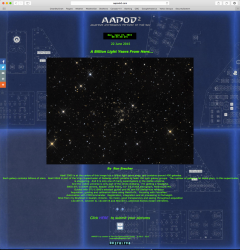Able 2065 Galaxy Cluster
Click image for full size version
April 27, 2015, Amateur Astronomy Picture of the Day June 22, 2015
 I know this isn’t as splashy as some of my images of showpiece objects, but it took more than a billion years to make! Yes. You heard right. A billion years. That is how long the light from Abell 2065’s dim galaxies had to travel before hitting my sensor. That makes this galaxy cluster the farthest object that I have ever imaged. I believe it contains more galaxies than any other image I have taken, with the possible exception of the Perseus A galaxy cluster, Abell 426.
I know this isn’t as splashy as some of my images of showpiece objects, but it took more than a billion years to make! Yes. You heard right. A billion years. That is how long the light from Abell 2065’s dim galaxies had to travel before hitting my sensor. That makes this galaxy cluster the farthest object that I have ever imaged. I believe it contains more galaxies than any other image I have taken, with the possible exception of the Perseus A galaxy cluster, Abell 426.
Abell 2065 is at the centre of this image, and contains around 400 galaxies. Each galaxy contains billions of stars. Abell 2065 is part of the Virgo Supercluster of Galaxies which contains at least 100 such galaxy groups. The number of galaxies, let alone stars, in this supercluster, is staggering. And it is only one of many superclusters in the visible universe. And the visible universe is only part of the whole shebang. I’m getting a headache.
Tekkies:
SBIG STL-11000M camera, Baader LRGB filters, 10″ f/6.8 ASA astrograph, Paramount MX. Guided with STL-11000’s external guider and 80 mm f/6 Stellar-Vue refractor. Acquistion, guiding and calibration done using Maxim-DL. Focusing with FocusMax. Automation with CCDCommander. Registration, integration and all processing in PixInsight. Shot from my SkyShed in Guelph, Ontario. No moon, good transparency and seeing throughout acquisition.
12x10m R, 12x10m G, 12x10m B and 50x10m L unbinned frames (total=14hr20m).
RGB:
Creation and cleanup: L, R, G and B masters were cropped. R, G and B were combined to make an RGB image which was processed with DBE and ColourCalibration.
Stretching: HistogramTransformation was applied to make a pleasing yet bright image.
Synthetic Luminance:
Creation and cleanup: The cropped L, R,G and B masters were combined using the ImageIntegration tool (average, additive with scaling, noise evaluation, iterative K-sigma / biweight midvariance, no pixel rejection). DBE was applied to neutralize the background.
Stretching: HistogramTransformation was applied to make a pleasing yet bright image.
Combining SynthL with RGB:
The luminance channel of the RGB was extracted, processed and then added back into the RGB image as follows:
1. Extract luminance from the RGB image.
2. Apply LinearFit using the SynthL channel as a reference.
3. Use ChannelCombination in Lab mode to replace the RGB’s luminance with the fitted luminance from step 2.
4. LRGBCombine was then used to make a SynthLRGB image.
Final Processing
Noise: SCNR was applied to reduce green noise. TGVDenoise was applied in Lab mode with only luminance selected and using default settings, except 300 iterations and convergence selected, followed by HistogramStretch. Background colour saturation was reduced slightly. A copy of the SynthL was processed with MultiscaleLinearTransformation with 4 layers and residual unchecked. Convolution (1 px) was applied to the result and this was used as a mask to boost colour saturation in the centre of the medium and small stars and galaxies.
Image scale is about 1.1 arcsec per pixel for this camera / telescope combination.







Leave A Comment